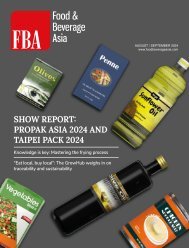Dental Asia May/June 2020
For more than two decades, Dental Asia is the premium journal in linking dental innovators and manufacturers to its rightful audience. We devote ourselves in showcasing the latest dental technology and share evidence-based clinical philosophies to serve as an educational platform to dental professionals. Our combined portfolio of print and digital media also allows us to reach a wider market and secure our position as the leading dental media in the Asia Pacific region while facilitating global interactions among our readers.
For more than two decades, Dental Asia is the premium journal in linking dental innovators
and manufacturers to its rightful audience. We devote ourselves in showcasing the latest dental technology and share evidence-based clinical philosophies to serve as an educational platform to dental professionals. Our combined portfolio of print and digital media also allows us to reach a wider market and secure our position as the leading dental media in the Asia Pacific region while facilitating global interactions among our readers.
Create successful ePaper yourself
Turn your PDF publications into a flip-book with our unique Google optimized e-Paper software.
Behind the Scenes<br />
First firing<br />
In order to make a visual comparison of the layers placed with the<br />
two ceramics, the materials were mixed with Liquid Visual Eyes<br />
(Harvest <strong>Dental</strong>). The Visual Eyes Liquid is a product that renders<br />
the colour of the fired ceramic visible before the material is actually<br />
fired (Figs. 8 – 9). The basic dentin layer was created with 25%<br />
Cervical Transpa orange-pink and 25% Cervical Transpa khaki<br />
mixed with 50% Dentin B2. Unmixed Dentin material was used<br />
in the central part. The incisal mamelons were produced with a<br />
mixture of 80% Dentin B2 and 20% Special Incisal grey. In the<br />
horizontal cut-back space, Effect material Inter Incisal white-blue<br />
was applied. The incisal margin was completed with Opal Effect<br />
OE 1 and Transpa materials (neutral, orange grey). The mamelons<br />
and internal characteristics were created with a fine separating<br />
instrument. After the first firing, the colours of IPS Style and IPS<br />
d.SIGN looked good and appeared almost identical (Fig. 10). IPS<br />
Style Ceram and IPS d.SIGN Transpa as well as Mamelon materials<br />
were used to make some slight adjustments to the shape of the<br />
anterior teeth. At this stage, a comparison showed that a few distal<br />
areas in the incisal edge of the IPS d.SIGN restoration were slightly<br />
more translucent.<br />
Customisation of the layers and second firing<br />
After the first corrective firing cycle, the teeth were customised<br />
with suitable IPS Ivocolor® stains. These materials are used to<br />
characterise restorations (e.g. mamelons), imitate enamel cracks<br />
and adjust the colour intensity and translucency of certain areas.<br />
Subsequently, the stains were fired. In this case, a reddish hue was<br />
imparted to the incisal edge with IPS Ivocolor Essence E21 basic<br />
red to achieve a “lip gloss infiltrated” effect in the dental enamel.<br />
For the second firing, the crowns were coated with Transpa Dentin,<br />
Transpa Incisal and Transpa Impulse (Figs. 11 – 13).<br />
Comparison of the results<br />
After the second corrective firing of the different IPS Style Ceram<br />
Transpa materials, we were convinced that the product fulfilled all<br />
our criteria: The dimensional and shade stability of the ceramic was<br />
impressive. We effectively controlled the brightness of the material<br />
by adding Transpa T neutral. All in all, we were completely satisfied<br />
with the result. The colours of IPS Style were lifelike and they were<br />
identical to those of IPS d.SIGN. A direct comparison clearly shows<br />
the excellent colour coordination of the different ceramic ranges<br />
(Figs. 14 – 15). Furthermore, the same shade system applies to<br />
the IPS e.max® all-ceramics and the SR Nexco® light-curing<br />
laboratory composite.<br />
Figs. 8 – 9: The ceramic materials were mixed with Liquid Visual Eyes for the purpose of visually<br />
comparing the two materials during the layering process<br />
(left: IPS d.SIGN; right: IPS Style)<br />
Fig. 10: Comparison of the crowns<br />
after the first firing<br />
(left: IPS d.SIGN; right: IPS Style)<br />
Fig. 11: Adjustment of the incisal teeth with<br />
Transpa and Mamelon materials<br />
(left: IPS d.SIGN; right: IPS Style)<br />
Fig. 12: Application of Transpa Dentin,<br />
Transpa Incisal and Transpa Impulse for the<br />
corrective firing cycle<br />
Fig. 13: The two anterior<br />
crowns after the<br />
corrective firing<br />
(left: IPS d.SIGN;<br />
right: IPS Style)<br />
52<br />
DENTAL ASIA MAY / JUNE <strong>2020</strong>


















